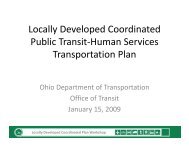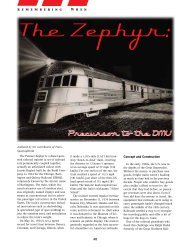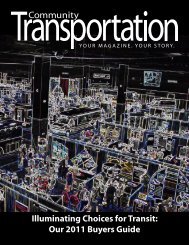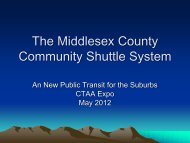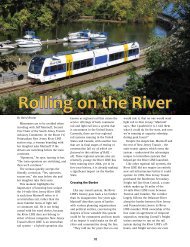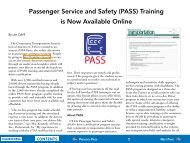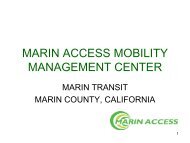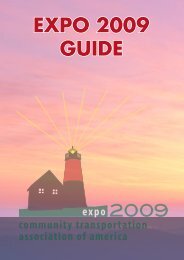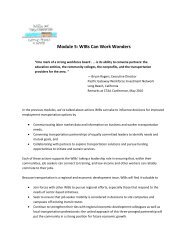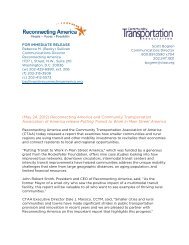San Luis Obispo - Caltrans - State of California
San Luis Obispo - Caltrans - State of California
San Luis Obispo - Caltrans - State of California
You also want an ePaper? Increase the reach of your titles
YUMPU automatically turns print PDFs into web optimized ePapers that Google loves.
SAN LUIS OBISPO REGION<br />
COORDINATED HUMAN SERVICES-PUBLIC TRANSPORTATION PLAN<br />
This Plan identifies, in Chapters 3 and 4, specific areas <strong>of</strong> individualized need for segments <strong>of</strong><br />
the target population that must be addressed on some level to improve mobility overall. Public<br />
transit and human service agencies and organizations must find ways in which to meet needs<br />
consumers describe, and agency/organization personnel enumerate on their behalf. Actions and<br />
strategies developed as elements <strong>of</strong> this plan have been designed to improve the ability <strong>of</strong><br />
operators <strong>of</strong> specialized transportation to serve a higher level <strong>of</strong> individualized trip needs with<br />
greater efficiency.<br />
6.4.4 Improving Communication Between Drivers, Dispatchers and Passengers and with<br />
Prospective Riders<br />
Improving communications between everyone involved in the provision <strong>of</strong> specialized<br />
transportation services can expand the capability <strong>of</strong> agencies and organizations to address<br />
individualized needs. Chapter 4 Stakeholder Outreach discusses the need for improved<br />
communication with persons who might be using public transit, in its many forms.<br />
Improved communication applies during the ride or in the process <strong>of</strong> obtaining a ride. This<br />
suggests continuing and differently focused driver training to sensitize both public fixed-route<br />
and paratransit drivers to recognize and facilitate transportation for persons with special needs.<br />
In addition, technological tools may improve the capability <strong>of</strong> the system to strengthen the<br />
connection between the rider, the vehicle and dispatch in a real-time situation. This will serve to<br />
minimize long waits, absent information about the vehicle’s arrival time. Dispatchers and call<br />
takers may require additional training to assist high-needs consumers more effectively and to be<br />
sensitized to their requirements.<br />
Capacity building then, for specialized transportation, has two purposes:<br />
1. To increase the quantity <strong>of</strong> what is available; and<br />
2. To improve the characteristics <strong>of</strong> what is available, whether in terms <strong>of</strong> measures <strong>of</strong><br />
cost-effectiveness, getting more for the dollars expended, or in terms <strong>of</strong> the types<br />
<strong>of</strong> service, greater responsiveness to the target populations.<br />
Both efforts can translate into more cost-effective programs with combined resources getting<br />
more for the dollars spent, and into more diversified approaches to meeting needs – different<br />
types <strong>of</strong> service in response to different target population needs.<br />
Capacity building becomes then an array <strong>of</strong> activities: training and pr<strong>of</strong>essional development,<br />
use <strong>of</strong> technologies to achieve increased efficiency and effectiveness, and all possible methods<br />
<strong>of</strong> expanding the quantities <strong>of</strong> service available.<br />
6.4.5 Areas Where Specialized Transit Demand May Exist<br />
Chapter 4 details a number <strong>of</strong> corridors and areas in the county where additional demand<br />
exists. These include temporal as well as geographic areas <strong>of</strong> need.<br />
Service Hours and Days<br />
As has been noted, expansion <strong>of</strong> operating hours <strong>of</strong> the county’s inter-community transit<br />
network is indicated where it can serve the trip needs between communities falling very early<br />
in the morning or later in the evening. Saturday service and Sunday service is indicated, for<br />
selected work trips, such as those required by hospitality industry workers where<br />
105<br />
OCTOBER 2007



